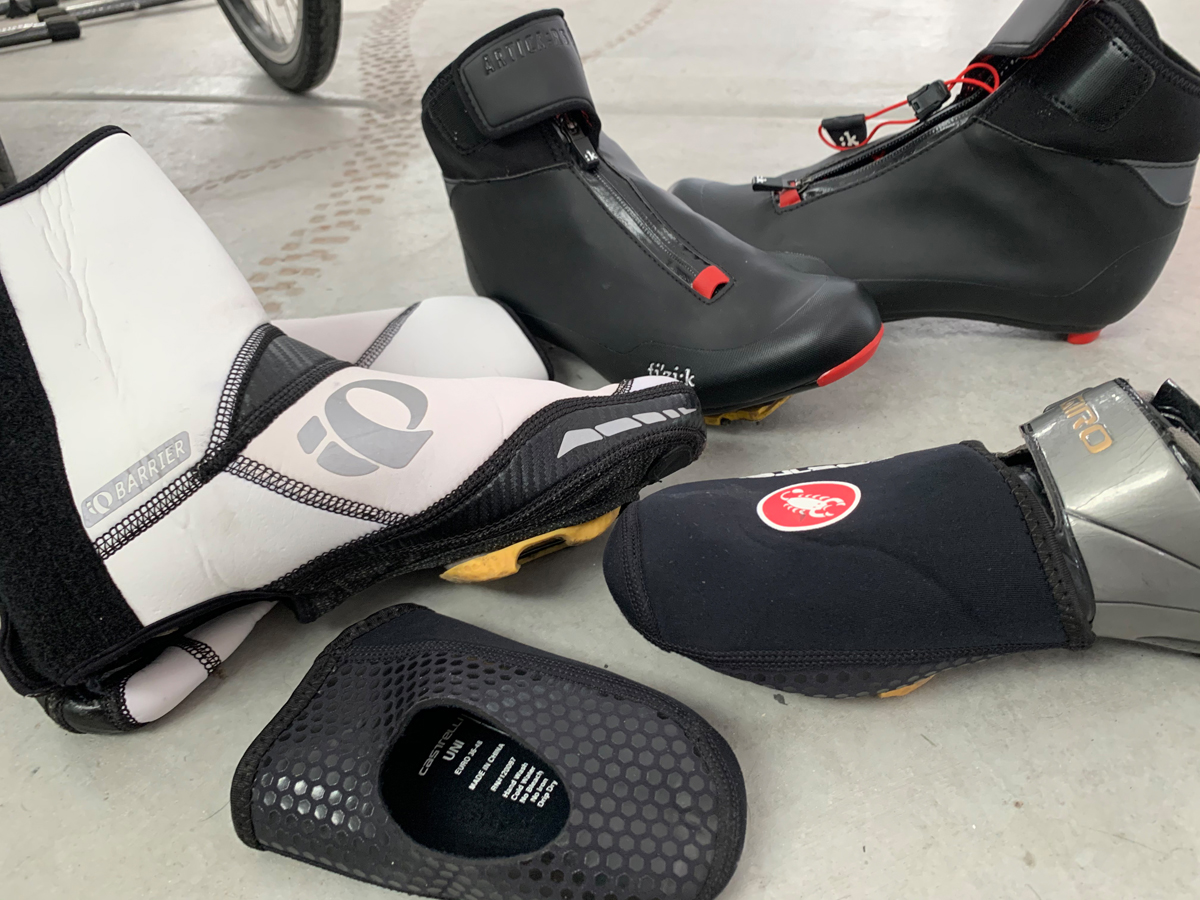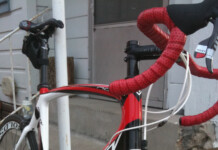By Jamie Morningstar — Most years I don’t worry too much about winter footwear for my road bike. My winter rides are usually limited to commuting to and from work, so I generally make do with platform pedals and some nice-looking waterproof boots that I wear all day at work. Or, occasionally, I’ll wear heavier boots to work and then change after arriving.
But, as we all know, 2020 was anything but ordinary. Like many folks, I’m still working from home. I miss the structure of my daily year-round cycle commute, but also enjoy the freedom of riding different bikes at different times of the day.

I’ve been riding my road bike a lot more this year, and as temperatures dip I’ve needed to break into my treasure trove (duffel bag) of warm cycling-specific clothing more liberally. Good thing I’m a total gear hound and am prepared for basically any cycle-wear need.
Road Bike Footwear Options
Once the temperatures dip below about 60, I find that my well-vented (well-used) road bike clipless shoes aren’t enough to keep my feet comfortable on rides. That’s when I put on the toe covers.
Basically, toe covers are three-inch neoprene sleeves that slide over the top half of your shoes. They are big enough to cover the vents in the front of your shoes and do a great job at keeping those tootsies toasty in cool temperatures. They have holes in the bottom to fit your cleat through.
Toe covers are great for so many reasons. They’re cheap. You don’t have to take them off to take your shoes on and off because they don’t cover the laces or straps on your shoes. They’re small, so you can easily slip them in a pocket if your toes start to overheat (this is not a thing my toes ever do).
Toe covers are just enough to take the edge off on cool mornings. But when the temperatures start to really descend, it’s time to kick it up a notch with full shoe covers.
Full shoe covers are neoprene booties with Velcro in the back to hold to secure the cover around your shoe and ankle. They encase your entire road shoe, with a hole in the bottom for your road cleat.
Up until this year, shoe covers have been all I’ve really needed for cold weather road bike footwear. They are super warm, the cuffs extend high enough to cover any sock-to-tight gaps that could open up and let cold air in, and they are reasonably priced.
The big downside with shoe covers is that they’re a bit of a pain to put on. Because they cover your entire road bike shoe, including all of the vents and buckles (pro), they are super warm, but you have to put your shoes on and then the covers on every time you want to wear them. Normally for the handful of times I use them during the year, this isn’t enough of a downside to warrant paying more for more convenient alternatives. But this year isn’t normal.
So, this year I sprung for some sweet winter road biking shoes! These shoes have all of the pros of the shoe covers (super warm, waterproof, no exposed vents or laces) without the inconvenience of putting covers on top of my shoes. There are very few winter road shoes out there for women (I found exactly zero) so I ended up buying men’s shoes in my size.
If you’re a Nordic skier, these shoes will feel uncannily familiar to you – they’re basically like skate ski boots but without the ankle support and with carbon soles. The shoes extend high up the ankle to eliminate gaps and close with an internal lace. Then there’s an outer covering that secures over the laces so that there are no spaces for wind to blow in. The shoes are warm and waterproof.
Other Options
To be honest, the most practical thing would have been for me to just buy a winter SPD shoe and swap my road bike pedals over to a cheap SPD pedal for the winter. Our friends in the mountain and fat bike communities have a ton of great winter riding SPD footwear options out there that are cheaper than the handful of winter road biking shoes available.
For me, my own internal laziness (I hate swapping pedals) and the fact that I had an extra pair of Speedplay cleats lying around pushed me over the edge to purchasing winter road shoes that work with my road pedals.
Also, I should mention that the photos in this article aren’t necessarily advocating the brand of shoes and covers I own. Most of the brands and styles I own correspond to whatever was on sale in my size at the time I happened to buy them. I like what I have, but I’m sure there are plenty of equally great options out there for you. My recommendation is to buy whatever is on sale in your size at the time you happen to buy them.
The moral of my story is that there are myriad options and tools out there to help you keep riding no matter the weather. Many of my friends choose to bring their bikes indoors and train inside in the winter months. Many commuters strap on the studded tires or swap to a fat bike and just keep riding outdoors. There’s no bad option here – just keep pedaling.









One other option you didn’t mention is to use battery-powered heated socks. Batteries are getting better and they have adjustable heat settings. They can offer a few hours of reasonable warmth at mid setting. Using these with toe warmers allows a few hours of road riding at temperatures down to 15-20.
My go-to option, so long as it’s dry and the temperature isn’t below freezing, is really simple: two layers of socks. I used to do the shoe covers but found the extra layer of socks to be just as effective in most conditions, and a lot easier to work with.
Disposable shoe specific warmers (pop open, shake up, insert) available at most sporting goods stores work well, also the hand variety worn under gloves are great too.
I ride road with bootie shoe covers but I don’t take them all the way off the shoes. I only peel them down far enough to get to the shore fasteners..
Put a disposable plastic sandwich bag over each wool sock and put your shoe on. Ziploc brand will even work, despite the ridged top. Makes a huge difference.
Per Bob Mirabel: “Old school”: put your feet in wool socks, then plastic bags (e.g. vegetable produce bags from your last grocery shopping trip), then shoes.
Comments are closed.